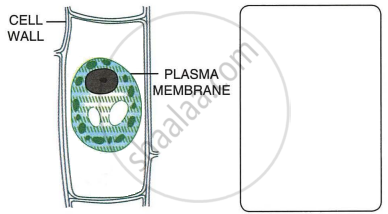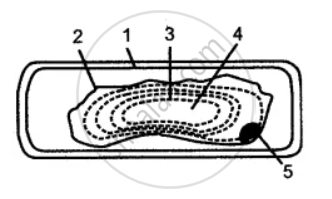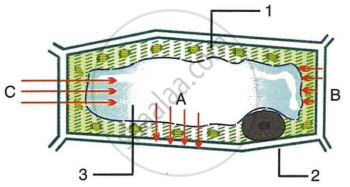Advertisements
Advertisements
प्रश्न
Addition of salt to pickles is a method of killing the bacteria by ______.
विकल्प
Imbibition
Diffusion
Deplasmolysis
Plasmolysis
उत्तर
Addition of salt to pickles is a method of killing the bacteria by plasmolysis.
Explanation:
Salt added to the pickle raises the solute concentration outside of the bacterial cells. As a result, water moves outside of the cell and kills the bacteria.
संबंधित प्रश्न
Give the equivalent term for the following:
The condition in which the cell contents are shrunken.
Differentiate between the following:
Turgor pressure and wall pressure
A leaf cell of a water plant was placed in a liquid other than pond water. After sometime, it assumed a shape as shown below:

- Give the term for the state of the cell it has acquired.
- Name the structure which acts as a selectively permeable membrane.
- Comment on the nature (tonicity) of the liquid surrounding the cell.
- Name any one feature of this plant cell which is not present in an animal cell.
- Redraw in the space provided, the diagram of the cell if it is soon placed in ordinary water for some time.
Give suitable biological reasons for the following statement:
Root hairs become flaccid and droop when excess fertilizers are added to the moist soil around them.
Differentiate between the following
Turgor pressure and Root pressure
Differentiate between the following:
Plasmolysis and Deplasmolysis.
The below diagram represents a plant cell after being placed in a strong sugar solution. Guidelines 1 to 5 indicate the following:
1. Cell wall
2. Plasma membrane.
3. Protoplasm
4. Large vacuole
5. Nucleus
Study the diagram and answer the questions that follow :
(i) What is the state of the cell shown in the diagram?
(ii) Name the structure which acts as a selectively permeable membrane.
(iii) If the cell had been placed in distilled water instead of a strong sugar solution which features: would not have been present?
(iv) If the cell in the diagram possessed chloroplasts where would these be present?
(v) Name any one feature of this plant cell which is not present in animal cells.
Give Technical Term for the following.
The pressure exerted by cell contents on a plant cell wall.
Name the following:
The process by which wilting or drooping of leaves occurs.
Given below is the figure of a plant cell showing different kinds of pressure acting upon it. Study the figure and answer the questions that follow:

- In the figure, 1, 2 and 3 represent:
- Cytoplasm, Nucleus, Vacuole respectively
- Vacuole, Cytoplasm, Cell wall respectively.
- Cytoplasm, Cell membrane and vacuole respectively.
- Cytoplasm, Cell wall and Vacuole respectively.
- B in the figure represents:
- Osmotic pressure
- Turgor pressure
- Wall pressure
- Diffusion pressure
- A in the figure represents:
- irnbibition pressure
- Wall pressure
- Turgor pressure
- Osmotic pressure
- C in the figure represents:
- Turgor pressure
- Osmotic pressure
- Wall pressure
- Imbibition pressure
- Draw a neat and labelled diagram of a plasmolyzed plant cell.
